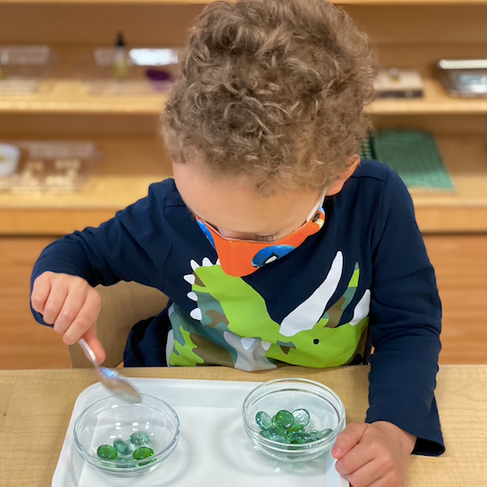Materials Spotlight: Transferring Objects in Practical Life
- kfinck6
- Jun 4, 2021
- 2 min read
What is the Practical Life area of the Montessori Classroom?
The Practical Life area in a Montessori classroom is an area that consists of work that develops motor control, a sense of order, coordination, develops independence, concentration, and a sense of responsibility. The exercises in Practical Life cover: care of self, care of the environment, care of plants and animals, and learning how to become an independent eater.

What does a spooning or transferring lesson look like?
When a child retrieves a spooning or transfer work from the Practical Life shelf they are embarking on a journey that indirectly prepares them for reading and longer works that they may encounter in other areas of the classroom. The spoon or utensil is always placed in the center of the tray, as the Montessori teacher never assumes whether a child is left or right handed.
What is the purpose of a lesson like this?
Grasping a handle and transferring helps children develop fine motor control. These simple activities isolate single skills children will later need, in combination, for more complex processes. One principle behind the activities Maria Montessori designed was that “control of error” be evident. Children learn to correct themselves in their work, eliminating the need for adults to point out mistakes. In this spirit, most of the dishes we offer are breakable. These works have both direct and indirect purposes. A transfer or spooning work directly works on creating a sense of order for the child, allowing them to learn how to transfer something with creating little to no spill. Indirectly the child is transferring objects from the left bowl to the right which is training the eye for reading, and strengthening the muscles in the hands, which is needed for a good pincer grip.

Are there any extensions or variations for this work?
Of course! Transferring activities can be adapted and rotated as the needs of your students and your environment change. For example, as the seasons change so can your objects, in the fall the child may spoon acorns or apples, and during the winter season they may spoon snowflakes. If you are doing a unit on dinosaurs the Practical Life shelf will change to meet the needs of the new given theme. To challenge older children in the Montessori classroom incorporating different heights by placing one bowl on the table and another on a chair can present a welcome challenge to even the veteran Montessorian in the class. The teacher may also add additional bowls or different utensils to transfer which incorporates Math, it teaches the child how to estimate in order to properly place the correct amount of objects in each given bowl.
















Comments